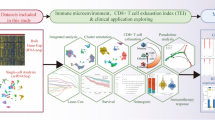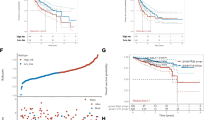Abstract
Functional rescue of NK-cells in solid tumors represents a central aim for new immunotherapeutic strategies. We have conducted a genomic, phenotypic and functional analysis of circulating NK-cells from patients with HCV-related liver cirrhosis and hepatocellular carcinoma. NK-cells were sorted from patients with HCC or liver cirrhosis and from healthy donors. Comparative mRNA gene expression profiling by whole-human-genome microarrays of sorted NK-cells was followed by phenotypic and functional characterization. To further identify possible mediators of NK-cell dysfunction, an in vitro model using media conditioned with patients’ and controls’ plasma was set up. Metabolic and cell motility defects were identified at the genomic level. Dysregulated gene expression profile has been translated into reduced cytokine production and degranulation despite a prevalent phenotype of terminally differentiated NK-cells. NKG2D-downregulation, high SMAD2 phosphorylation and other phenotypic and molecular alterations suggested TGF-β as possible mediator of this dysfunction. Blocking TGF-β could partially restore functional defects of NK-cells from healthy donors, exposed to TGF-β rich HCC patients’ plasma, suggesting that TGF-β among other molecules may represent a suitable target for immunotherapeutic intervention aimed at NK-cell functional restoration. By an unbiased approach, we have identified energy metabolism and cell motility defects of circulating NK-cells as main mechanisms responsible for functional NK-cell impairment in patients with hepatocellular carcinoma. This opens the way to test different approaches to restore NK-cell response in these patients.






Similar content being viewed by others
References
Chiossone L, Dumas PY, Vienne M, Vivier E (2018) Natural killer cells and other innate lymphoid cells in cancer. Nat Rev Immunol 18:671–688
Guillerey C, Chow MT, Miles K, Olver S, Sceneay J, Takeda K et al (2015) Toll-like receptor 3 regulates NK cell responses to cytokines and controls experimental metastasis. Oncoimmunology 4:e1027468
O’Brien KL, Finlay DK (2019) Immunometabolism and natural killer cell responses. Nat Rev Immunol. https://doi.org/10.1038/s41577-019-0139-2
Kulik L, El-Serag HB (2019) Epidemiology and management of hepatocellular carcinoma. Gastroenterology 156:477–491.e1
Singal AG, El-Serag HB (2015) Hepatocellular carcinoma from epidemiology to prevention: translating knowledge into practice. Clin Gastroenterol Hepatol 13:2140–2151
Taketomi A, Shimada M, Shirabe K, Kajiyama K, Gion T, Sugimachi K (1998) Natural killer cell activity in patients with hepatocellular carcinoma: a new prognostic indicator after hepatectomy. Cancer 83:58–63
Hoechst B, Voigtlaender T, Ormandy L, Gamrekelashvili J, Zhao F, Wedemeyer H et al (2009) Myeloid derived suppressor cells inhibit natural killer cells in patients with hepatocellular carcinoma via the NKp30 receptor. Hepatology 50:799–807
Cai L, Zhang Z, Zhou L, Wang H, Fu J, Zhang S et al (2008) Functional impairment in circulating and intrahepatic NK-cells and relative mechanism in hepatocellular carcinoma patients. Clin Immunol 129:428–437
Wu Y, Kuang DM, Pan WD, Wan YL, Lao XM, Wang D, Li XF, Zheng L (2013) Monocyte/macrophage-elicited natural killer cell dysfunction in hepatocellular carcinoma is mediated by CD48/2B4 interactions. Hepatology 57:1107–1116
Iñarrairaegui M, Melero I, Sangro B (2018) Immunotherapy of hepatocellular carcinoma: facts and hopes. Clin Cancer Res 24:1518–1524
Cariani E, Pilli M, Barili V, Porro E, Biasini E, Olivani A et al (2018) Natural killer cells phenotypic characterization as an outcome predictor of HCV-linked HCC after curative treatments. Oncoimmunology 5:e1154249
Burshtyn BN, Shin J, Stebbins C, Long EO (2000) Adhesion to target cells is disrupted by killer cell inhibitory receptor. Curr Biol 10:700–780
Troiano L, Ferraresi R, Lugli E, Nemes E, Roat E, Nasi M et al (2007) Multiparametric analysis of cells with different mitochondrial membrane potential during apoptosis by polychromatic flow cytometry. Nat Protoc 2:2719–2727
Clayton A, Mitchell JP, Court J, Linnane S, Mason MD, Tabi Z (2008) Human tumor-derived exosomes down-modulate NKG2D expression. J Immunol 180:7249–7258
Gardiner CM, Finlay DK (2017) What fuels natural killers? Metabolism and NK Cell responses. Front Immunol 8:367
Keating SE, Zaiatz-Bittencourt V, Loftus RM, Keane C, Brennan K, Finlay DK et al (2016) Metabolic reprogramming supports IFN-γ production by CD56bright NK cells. J Immunol 196:2552–2560
Golden-Mason L, Madrigal-Estebas L, McGrath E, Conroy MJ, Ryan EJ, Hegarty JE et al (2008) Altered natural killer cell subset distributions in resolved and persistent hepatitis C virus infection following single source exposure. Gut 57:1121–1128
Fu B, Wang F, Sun R, Ling B, Tian Z, Wei H (2011) CD11b and CD27 reflect distinct population and functional specialization in human natural killer cells. Immunology 133:350–359
Zhang QF, Yin WW, Xia Y, Yi YY, He QF, Wang X et al (2017) Liver-infiltrating CD11b(-)CD27(-) NK subsets account for NK-cell dysfunction in patients with hepatocellular carcinoma and are associated with tumor progression. Cell Mol Immunol 14:819–829
Chiossone L, Chaix J, Fuseri N, Roth C, Vivier E, Walzer T (2009) Maturation of mouse NK cells is a 4-stage developmental program. Blood 113:5488–5496
Simonetta F, Pradier A, Roosnek E (2016) T-bet and eomesodermin in NK cell development, maturation, and function. Front Immunol 7:241
Yu J, Mao HC, Wei M, Hughes T, Zhang J, Park IK et al (2010) CD94 surface density identifies a functional intermediary between the CD56bright and CD56dim human NK-cell subsets. Blood 115:274–281
Michelet X, Dyck L, Hogan A, Loftus RM, Duquette D, Wei K et al (2018) Metabolic reprogramming of natural killer cells in obesity limits antitumor responses. Nat Immunol 19:1330–1340
Harmon C, Robinson MW, Hand F, Almuaili D, Mentor K, Houlihan DD et al (2019) Lactate-mediated acidification of tumor microenvironment induces apoptosis of liver-resident NK cells in colorectal liver metastasis. Cancer Immunol Res 7:335–346
Mantovani S, Oliviero B, Lombardi A, Varchetta S, Mele D, Sangiovanni A et al (2019) Deficient natural killer cell NKp30-mediated function and altered NCR3 splice variants in hepatocellular carcinoma. Hepatology 69:1165–1179
Duan S, Guo W, Xu Z, He Y, Liang C, Mo Y et al (2019) Natural killer group 2D receptor and its ligands in cancer immune escape. Mol Cancer 18:29
Zaiatz-Bittencourt V, Finlay DK, Gardiner CM (2018) Canonical TGF-β signaling pathway represses human NK cell metabolism. J Immunol 200:3934–3941
Castriconi R, Dondero A, Bellora F, Moretta L, Castellano A, Locatelli F et al (2013) Neuroblastoma-derived TGF-β1 modulates the chemokine receptor repertoire of human resting NK cells. J Immunol 190:5321–5328
Shirai Y, Kawata S, Tamura S, Ito N, Tsushima H, Takaishi K et al (1994) Plasma transforming growth factor-beta 1 in patients with hepatocellular carcinoma. Comparison with chronic liver diseases. Cancer 73:2275–2279
Sacco R, Leuci D, Tortorella C, Fiore G, Marinosci F, Schiraldi O et al (2000) Transforming growth factor beta1 and soluble Fas serum levels in hepatocellular carcinoma. Cytokine 12:811–814
Dituri F, Mancarella S, Cigliano A, Chieti A, Giannelli G (2019) TGF-β as multifaceted orchestrator in HCC progression: signaling, EMT, immune iicroenvironment, and novel therapeutic perspectives. Semin Liver Dis 39:53–69
Peng H, Tian Z (2017) Diversity of tissue-resident NK cells. SeminImmunol 31:3–10
Easom NJW, Stegmann KA, Swadling L, Pallett LJ, Burton AR, Odera D et al (2018) IL-15 overcomes hepatocellular carcinoma-induced NK cell dysfunction. Front Immunol 9:1009
Funding
Italian Association for Cancer Research (AIRC) IG 15485; Accelerator Award 22794 (AIRC, CRUK, AECC).
Author information
Authors and Affiliations
Contributions
AZ was involved in study concept and design, analysis and interpretation of data, drafting of the manuscript, critical revision of the manuscript for important intellectual content and statistical analysis. VB was involved in study concept and design, analysis and interpretation of data, drafting of the manuscript, critical revision of the manuscript for important intellectual content and statistical analysis Diana Canetti was involved in statistical analysis and technical support; VR was involved in statistical analysis and technical support; AO was involved in acquisition of data and analysis and interpretation of data; CC was involved in statistical analysis. VC was involved in technical support; BZ was involved in technical support; TT was involved in funding contribution and critical revision of the manuscript. RDV was involved in acquisition of data and analysis and interpretation of data; CF was involved in critical revision of the manuscript for important intellectual content; EC was involved in study concept and design, analysis and interpretation of data, drafting of the manuscript, critical revision of the manuscript for important intellectual content, obtained funding and statistical analysis. GM was involved in study concept and design, analysis and interpretation of data, drafting of the manuscript, critical revision of the manuscript for important intellectual content, obtained funding and study supervision.
Corresponding author
Ethics declarations
Conflict of interest
CF: Consultant for Gilead, Abbvie, Arrowhead.
Additional information
Publisher's Note
Springer Nature remains neutral with regard to jurisdictional claims in published maps and institutional affiliations.
Electronic supplementary material
Below is the link to the electronic supplementary material.
Rights and permissions
About this article
Cite this article
Zecca, A., Barili, V., Canetti, D. et al. Energy metabolism and cell motility defect in NK-cells from patients with hepatocellular carcinoma. Cancer Immunol Immunother 69, 1589–1603 (2020). https://doi.org/10.1007/s00262-020-02561-4
Received:
Accepted:
Published:
Issue Date:
DOI: https://doi.org/10.1007/s00262-020-02561-4




